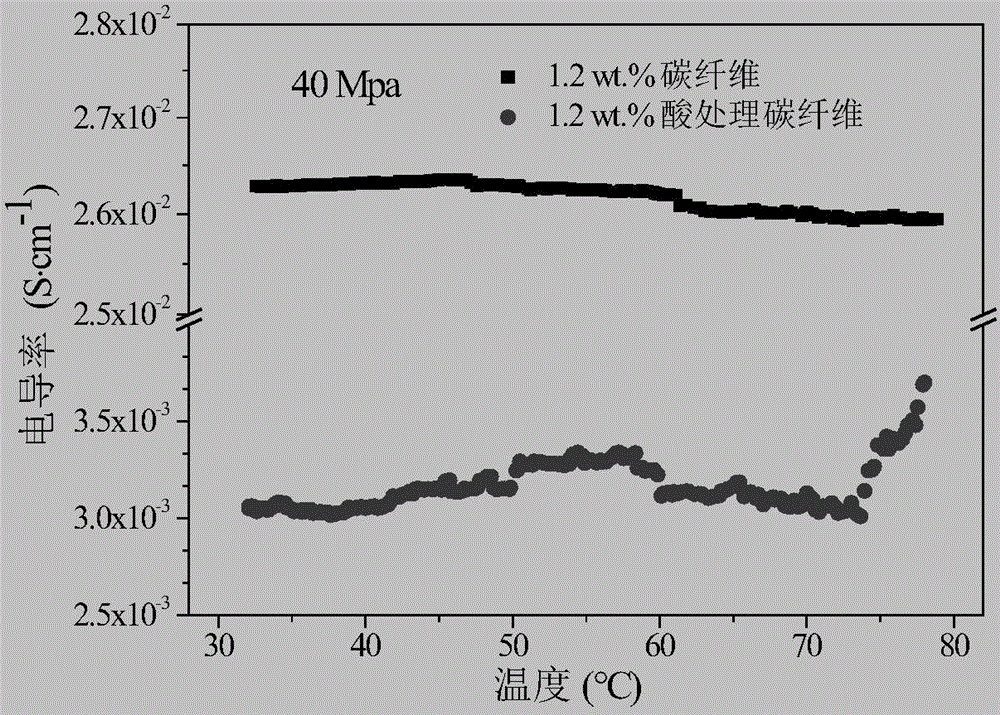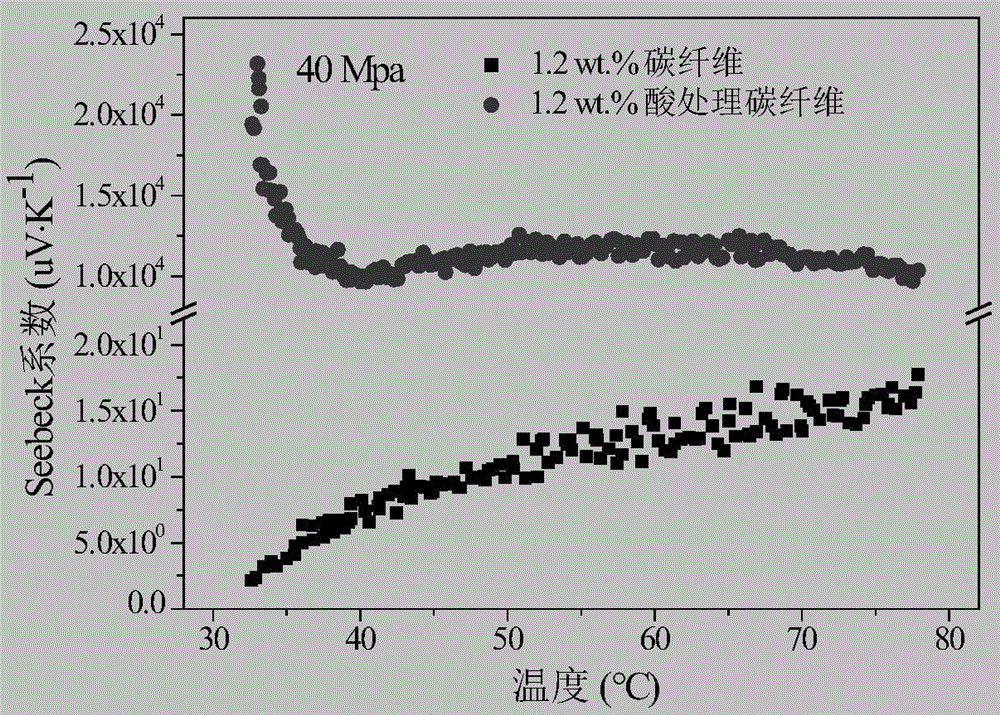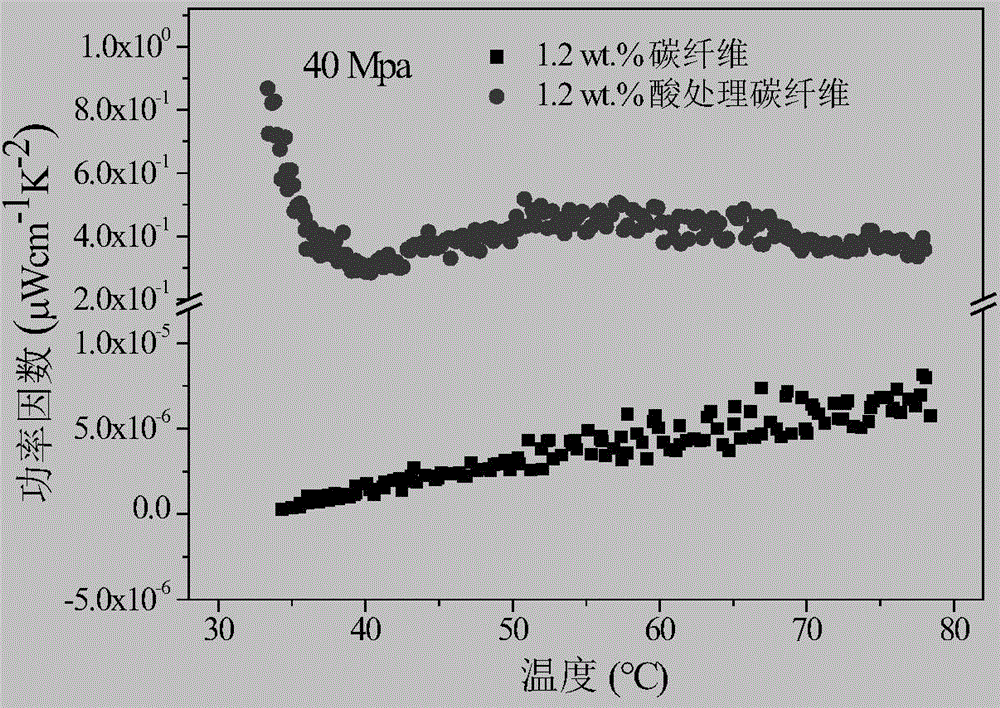Method for improving Seebeck coefficient of carbon fiber cement-based composite material
A composite material and carbon fiber technology, which is applied in the field of cement-based composite material preparation, can solve the problems of low thermoelectric performance of carbon fiber cement-based composite materials, large environmental pollution risk of bromine vapor, complex process of bromine intercalated carbon fiber, etc., to avoid poor thermoelectric performance High, avoiding the effect of low thermoelectric performance and improving thermoelectric performance
- Summary
- Abstract
- Description
- Claims
- Application Information
AI Technical Summary
Problems solved by technology
Method used
Image
Examples
Embodiment 1
[0026] Prepare a steel mold with a cuboid cavity, and weigh carbon fiber and sulphoaluminate cement without acid treatment according to a mass ratio of 1.2:100.
[0027] The untreated carbon fiber was uniformly dispersed in the cement matrix by using a wheel-type sand mixer, and the uniformly mixed powder was dry-pressed with a steel mold at a pressure of 40Mpa, and then cured to form a carbon fiber cement-based composite material sample.
[0028] A flat heater is used to generate a temperature difference ΔT on the two opposite sides of the carbon fiber cement-based composite sample, one of which is gradually heated to 100°C by the flat heater (heating rate is 0.01°C / s), and the other side is at ambient temperature (Another flat heater heats the ambient temperature at the same heating rate after 10 minutes). During the heating process, the thermoelectric potential ΔV, the temperature difference ΔT and the resistance value generated between the two opposite sides were simultane...
Embodiment 2
[0030] Prepare a steel mold with a cuboid cavity, and weigh acid-treated carbon fiber and sulphoaluminate cement according to a mass ratio of 1.2:100.
[0031] The acid-treated carbon fiber was uniformly dispersed in the cement matrix by using a wheel-type sand mixer, and the uniformly mixed powder was dry-pressed with a steel mold under a pressure of 40Mpa, and cured to form an acid-treated carbon fiber cement-based composite material sample.
[0032] A flat heater is used to generate a temperature difference ΔT between the two opposite sides of the acid-treated carbon fiber cement-based composite sample, one of which is gradually heated to 100°C by the flat heater (heating rate is 0.01°C / s), and the other side is at Ambient temperature (another flat heater heats the ambient temperature at the same heating rate after 10 minutes). During the heating process, the thermoelectric potential ΔV, the temperature difference ΔT and the resistance value generated between the two opposi...
Embodiment 3
[0034] Prepare a steel mold with a cuboid cavity, weigh acid-treated carbon fiber and Portland cement at a mass ratio of 1:100, and add an appropriate amount of aggregate at the same time.
[0035] The acid-treated carbon fiber was uniformly dispersed in the cement matrix by using a wheel-type sand mixer, and the uniformly mixed powder was dry-pressed with a steel mold under a pressure of 60Mpa, and cured to form an acid-treated carbon fiber cement-based composite material sample.
[0036]A flat heater is used to generate a temperature difference ΔT between the two opposite sides of the acid-treated carbon fiber cement-based composite sample, one of which is gradually heated to 100°C by the flat heater (heating rate is 0.01°C / s), and the other side is at Ambient temperature (another flat heater heats the ambient temperature at the same heating rate after 10 minutes). During the heating process, the thermoelectric potential ΔV, the temperature difference ΔT and the resistance v...
PUM
| Property | Measurement | Unit |
|---|---|---|
| length | aaaaa | aaaaa |
Abstract
Description
Claims
Application Information
 Login to View More
Login to View More - R&D
- Intellectual Property
- Life Sciences
- Materials
- Tech Scout
- Unparalleled Data Quality
- Higher Quality Content
- 60% Fewer Hallucinations
Browse by: Latest US Patents, China's latest patents, Technical Efficacy Thesaurus, Application Domain, Technology Topic, Popular Technical Reports.
© 2025 PatSnap. All rights reserved.Legal|Privacy policy|Modern Slavery Act Transparency Statement|Sitemap|About US| Contact US: help@patsnap.com



